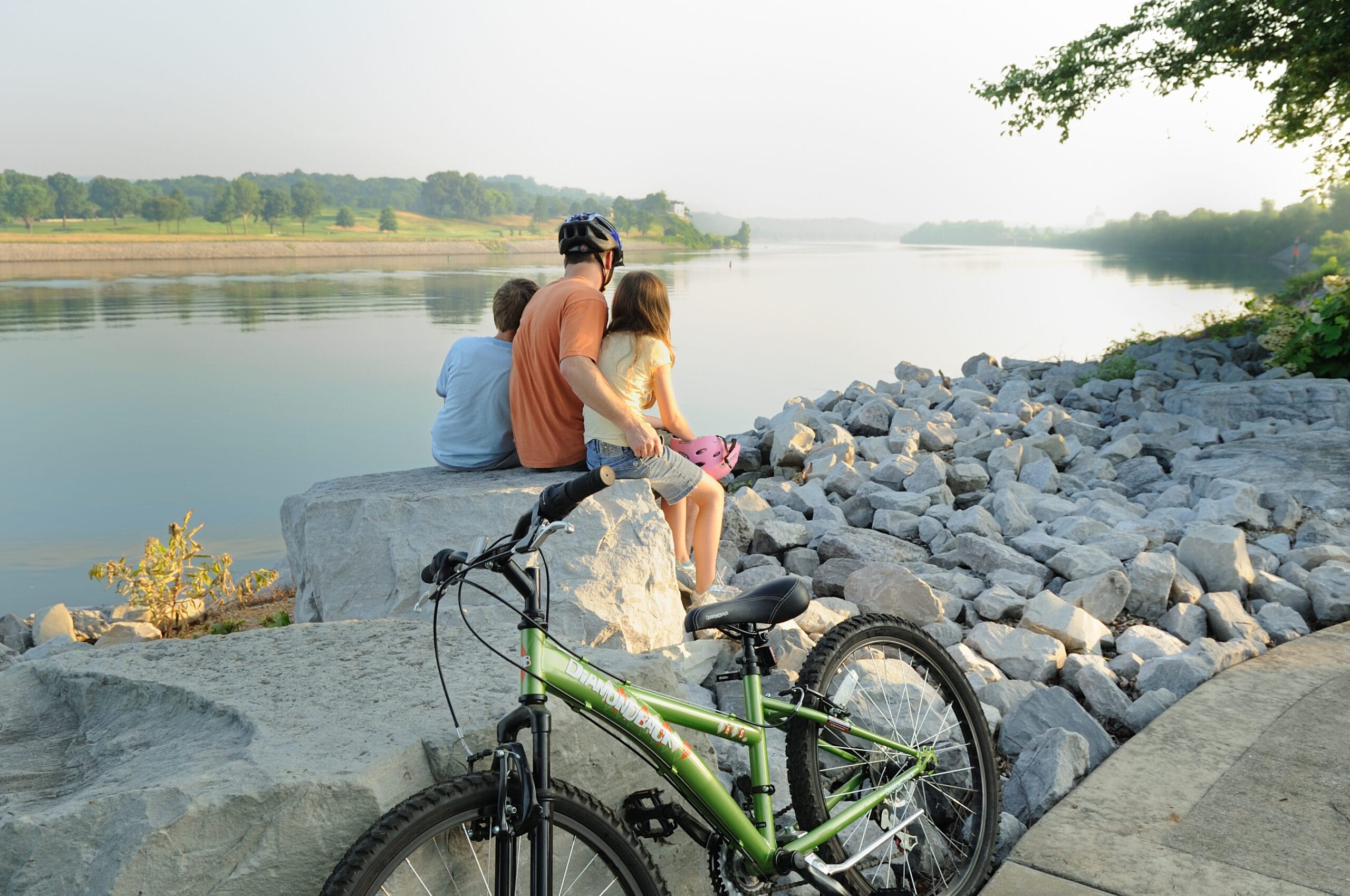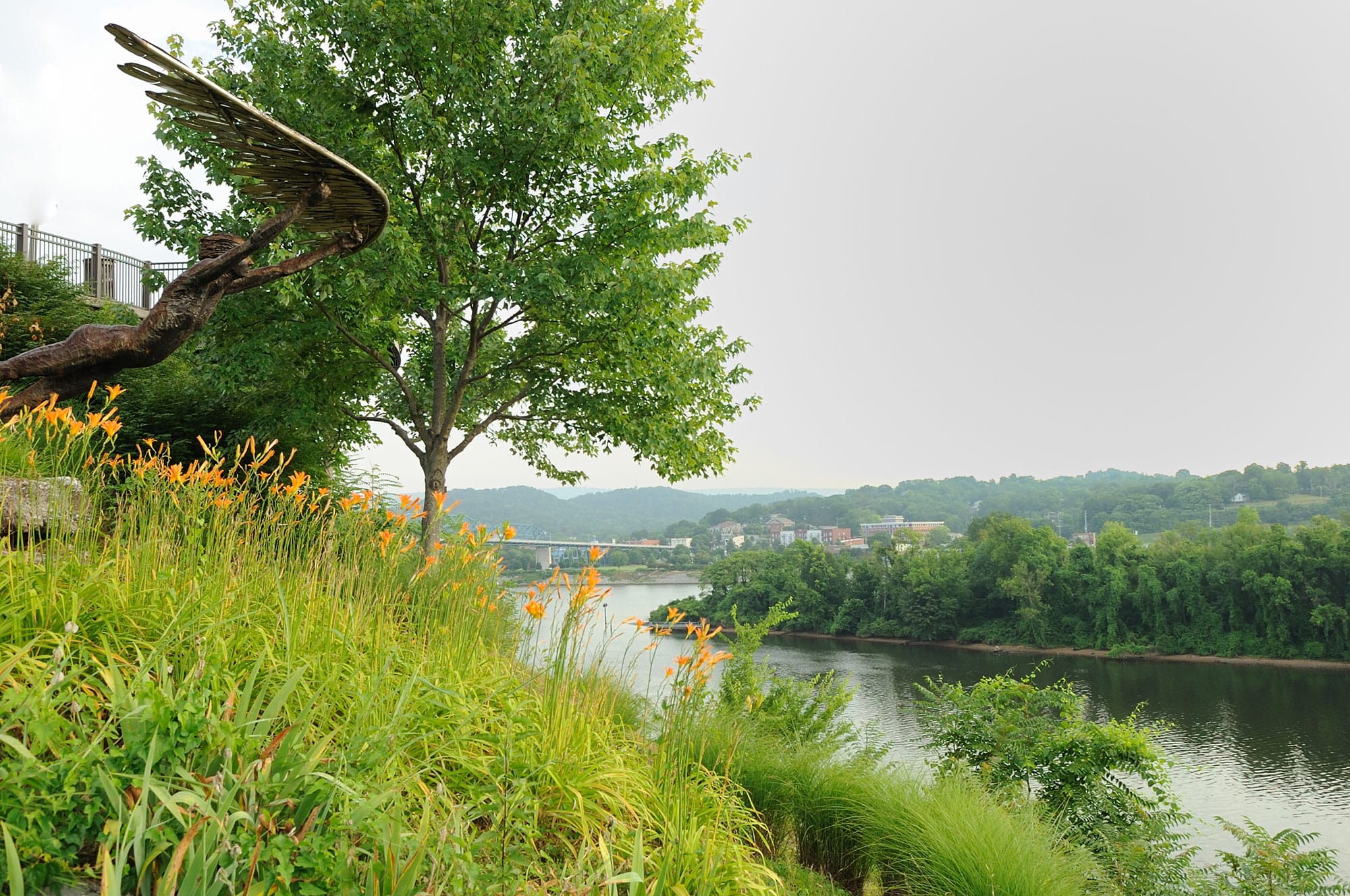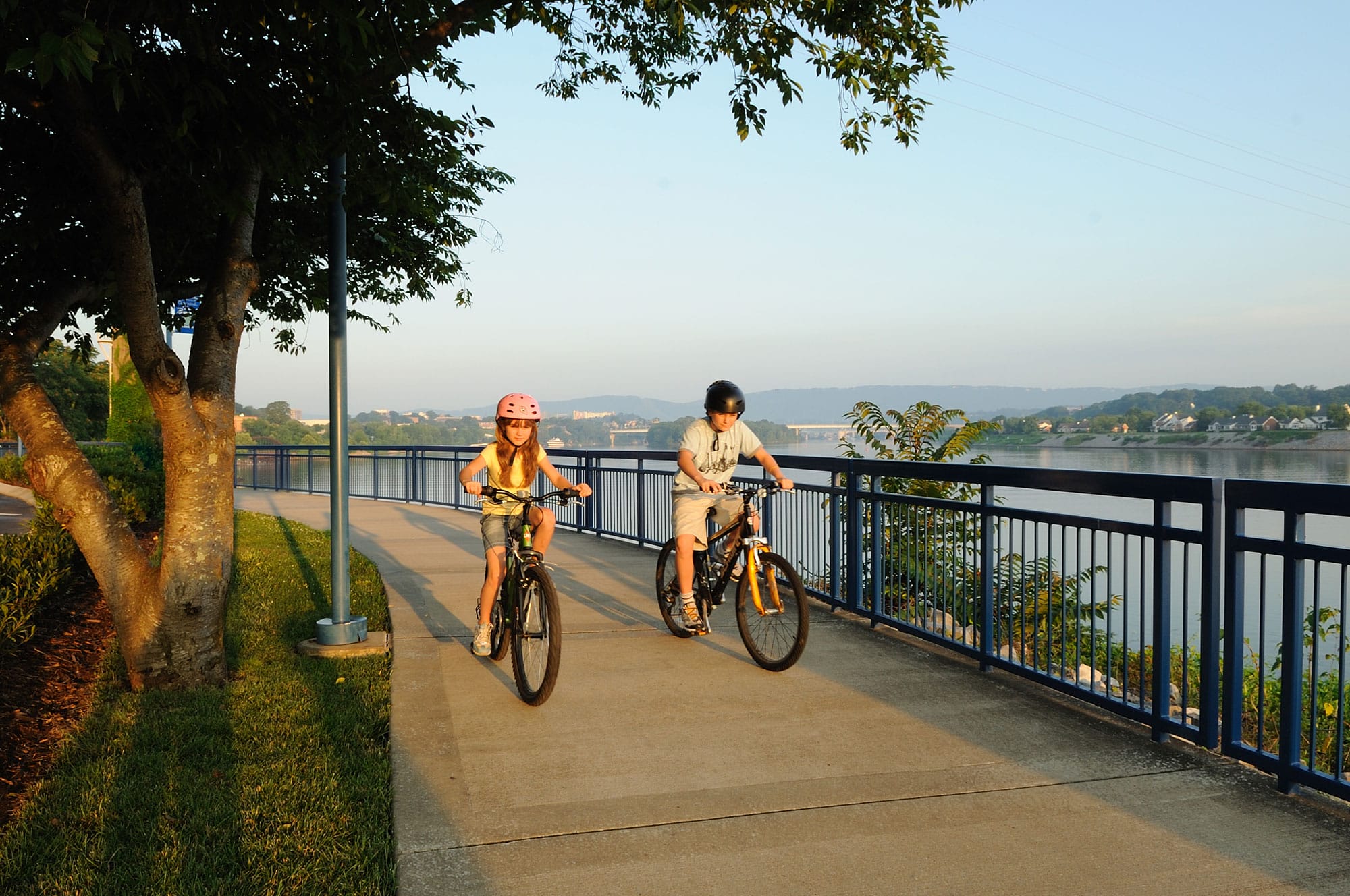Professional trail designer Woody Keen is taking a break to enjoy the view at a natural lookout on Stringer’s Ridge in Chattanooga, Tennessee. Some 300 feet below, the Tennessee River bisects the city before heading west to the Tennessee River Gorge. To the south, beyond a hairpin turn in the river known as Moccasin Bend, looms Lookout Mountain, the site of a prominent Civil War battle. Missionary Ridge, another battlefield, corrals the city center to the east.
“We’ll build a cantilevered wooden overlook here,” Keen indicates, “with seating, so people can sit, read a book, or watch the sunset.”
It seems as if we can see forever; it’s hard to believe that Chattanooga was once declared the dirtiest city in America, with air so thick that motorists needed headlights to drive during the day.
From the overlook, a series of stakes bearing fluorescent orange flags mark the course of a new trail beneath an oak-and-hickory canopy. In 2009, Trust for Public Land acquired Stringer’s Ridge for a Chattanooga city park and now has hired Keen to lace the ridge with nearly eight miles of trails. “We want new people to visit,” Woody says, “and we want everyone to stay longer.” Keen is all about connecting people with the land.
The same could be said for Chattanooga. The preservation and opening of Stringer’s Ridge for public use are emblematic of Chattanooga’s commitment to open space and quality of life as a key to its economic future.
Support TPL’s work in Tennessee by making a donation today.
In recent years this strategy has yielded stunning success, as the once-polluted city has become a magnet for tourists and attracted businesses small and large. In 2010, a major Volkswagen manufacturing plant brought with it more than 2,000 jobs. No one is suggesting that parks, trails, and outdoor access are the only reason for Chattanooga’s boom, but they are clearly a major factor.
“One of the attractions for Volkswagen was that the site we presented to them is adjacent to a newly created, 2,800-acre nature preserve and park,” says David Crockett, director of the city’s Office of Sustainability. “Companies want their employees to have places to walk and bike and enjoy the land.”
“Every place I go in the Southeast, I hear planners and business leaders making reference to Chattanooga,” says Peter Harnik, director of Trust for Public Land’s Center for City Park Excellence. “They may say, ‘Our vision is to create another Chattanooga,’ or ‘I’d be happy if we could accomplish just half as much as Chattanooga’s done.’ For a city of only 167,000, Chattanooga has become highly influential—both for its can-do attitude and for its unquestionably successful results.”
A Polluted Past
It was not always so. Chattanooga was a rail and industrial hub long before Glenn Miller’s 1941 big-band hit “Chattanooga Choo Choo” forever linked the town with trains. The great Civil War battles of Chickamauga and Chattanooga were fought because the convergence of rail lines made this the gateway to the Deep South.
The Civil War brought Northerners to Chattanooga, and they brought industrialization. During the war, Union general John T. Wilder shelled Chattanooga from Stringer’s Ridge. After the war, he returned to establish the Roan Iron Works, by 1871 the city’s largest employer. Heavy industry mushroomed; Chattanooga became known as the “Dynamo of Dixie.” Factories and coal furnaces pumped out clouds of particulate pollution. Because the surrounding ridges create a natural bowl where polluted cold air becomes trapped beneath a blanket of warmer air, by the mid-1900s, the city was literally choking.
In 1969, Walter Cronkite announced on the CBS Evening News that Chattanooga was the dirtiest city in the nation. It was a stunning wake-up call. Within the year, Chattanoogans adopted aggressive legislation restricting almost every pollution-causing activity in the area. Incredibly, within three years, every major pollutiongenerating facility was in compliance.
But Rust Belt deindustrialization had already begun, and for many factories the cost of cleaning the air was simply too high. Those companies simply closed up shop. Unemployment soared; the tax base shrank. Chattanooga was no longer choking, but it was in danger of dying. Like Buffalo, Cleveland, Detroit, and other cities dependent on heavy industry, Chattanooga struggled with the issue of survival—how to create a future in a new economy.

A family stops for a break along the Riverwalk in Chattanooga. Photo: Darcy Kiefel
Return to the River
Trust for Public Land Tennessee director Rick Wood leans over a 50-square-foot topographical map in TPL’s offices in a converted home near the Tennessee River. Since 1994, TPL has been helping to build the Tennessee Riverwalk, which traces the river through the city at the heart of a growing regional greenway system. “The green dots mark the completed Riverwalk,” Wood explains. “The red dots are where we are working to acquire property or easements.”
Like so many waterfront cities, Chattanooga long saw its river as a resource for commerce, not for people. Before the 1980s, much of the riverfront was industrial; urban buildings faced inland, their backs to the water. But as the city began to contemplate its postindustrial future, the river emerged once more as a key resource—now for people rather than industry. A series of citizen visioning and planning efforts culminated in 1985 with the release of the Tennessee Riverpark Master Plan, which called for $750 million in new development along the river and conservation of 22 miles of river corridor through Chattanooga.
Today the riverfront features an aquarium, a children’s discovery museum, a visitor center, an IMAX 3D theater, and a conference center, which in turn have attracted more than 100 new shops, hotels, and restaurants, along with a flurry of private investment. Threading through it all, the ten-mile riverbank greenway connects areas as disparate as downtown’s Coolidge Park, popular for outdoor concerts and its century-old restored carousel; Renaissance Park, a 23-acre urban wetland; Ross’s Landing, site of the original Cherokee trading post around which the city was founded and home since 1992 of the Tennessee Aquarium; and the Chickamauga Dam, a power generation facility operated by the Tennessee Valley Authority.
On Wood’s map, green dots of completed Riverpark march along both banks of the river downtown, connecting over the historic Walnut Street Bridge. Built in 1890 and closed to traffic in 1978, the bridge was almost torn down before the city made it part of the greenway system. At nearly a half-mile long, it is one of the longest pedestrian bridges in the world. At the south end of the bridge, a four-foot-tall bronze sculpture of a Great Dane, forepaw raised in greeting, welcomes a steady parade of strollers, dog walkers, joggers, and cyclists. The Riverpark, with its openness, its whimsical mile-marker sculptures, its abundance of picnic areas and countless other peoplefriendly amenities, imparts an almost European feel. It has clearly become part of the fabric of the city. At the city’s request, TPL also is working to extend greenways from the Riverpark along tributary streams such as North and South Chickamauga Creeks.
“We are one easement away from being able to open another 3.5-mile segment of the South Chickamauga Creek Greenway,” Rick Wood says. He expects to have the real estate secured for the entire 14-mile trail by late spring. In the meantime, the Riverwalk itself is growing, with plans that will nearly double its length. One extension will reach to the Moccasin Bend National Archeological District, enclosed by that hairpin turn of the river and with records of Native American presence from the time of the Cherokee removal all the way back to the Paleo-Indian period. Another will take trail users to the Lookout Mountain battlefield protected by the Chickamauga and Chattanooga National Military Park. The Trust for Public Land has helped to build both park sites over the years.
Attracting New Industry
It’s time to visit red-dot territory. Rick Wood drives us beyond the Riverpark terminus into an industrial area where loom two huge new industrial plants. A towering 1,000-ton gantry adds a Star Wars touch to the site. The plants belong to Alstom, a major international player in electric power. One facility builds huge boilers and the second constructs massive turbines. The boiler plant has been in Chattanooga for years but has been newly refurbished. The turbine facility, a new investment in excess of $200 million, represents some 300 new jobs. Both plants meet the highest energy-efficiency and environmental standards.
What does a major new industrial investment have to do with the Riverpark? It’s simple, explains Rick Wood. “Alstom raised the issue of the Riverpark in their negotiations with the city. They wanted assurances that it would be extended to their facility!” TPL is now working to do just that: getting easements in place so the city can build the extension. “It will come right through here,” Wood says, “and pass directly under the gantry.”
If bringing Alstom’s turbine plant to Chattanooga was a coup, landing Volkswagen’s assembly plant was seismic. The 2010 announcement was made at the Hunter Museum of American Art, on the bluffs overlooking the Tennessee River with Stringer’s Ridge in the background. The gathered crowd cheered out loud when Volkswagen of America’s President Stephan Jacoby, accompanied by Governor Phil Bredesen, formally announced that Volkswagen was coming to Chattanooga.
Small wonder: the assembly plant, originally planned to produce 150,000 vehicles a year—a capacity already surpassed—brought 2,000 new jobs and a $1 billion investment in the region’s economy. And that doesn’t count the 19 major auto parts suppliers that have relocated to Chattanooga to support the facility.
“We made a conscious effort to pitch our quality of life, including all we’ve done to revitalize downtown, create parks and green space, clean up our air, and generally be good stewards of the environment,” says Trevor Hamilton, vice president for economic development of the Chattanooga Area Chamber of Commerce. Jacoby, in announcing Volkswagen’s decision, lauded Chattanooga’s “vision of a clean, healthy city along with the protection of its natural beauty.”

A statue of Icarus above the Tennessee River in Chattanooga with Stringer’s Ridge is in the distance. Photo: Darcy Kiefel
Protecting Stringer’s Ridge
Carla Askonas, The Trust for Public Land’s former associate director of philanthropy in Chattanooga, calls the overlook on Stringer’s Ridge “the milliondollar view” because of the inspirational effect it has on donors.
The iconic ridge—four hilltops totaling 92 acres of undeveloped forest—dominates the city’s northern viewshed, providing a green backdrop for downtown. In 2007 the most recent of several development plans called for six-story condos lining the ridgecrest. After strident opposition from Chattanoogans shut down the proposal, TPL stepped in at the city’s request to raise funds for the land’s protection. One key strategy was to conduct tours of the ridge for potential contributors, always stopping at the overlook. “The project just got people excited,” Askonas says. “One donor took in the view, turned, and said simply, ‘Count me in for twenty-five thousand dollars.'”
It was not an easy time to raise the $2.4 million needed to protect the ridge. The economy had just tanked, and the stock market with it. But the community stepped up. The Lyndhurst Foundation, a local philanthropy, committed nearly $850,000, much of it in matching funds. The city found money, as did other foundations and more than 20 companies and nonprofits. Today, with Stringer’s Ridge a solid dark green on Rick Wood’s map, attention has turned to building trails in the new park and connecting it to Chattanooga’s growing network of greenways and open space.
Gone are the (literally) dark days, when Chattanoogans drove with their headlights on in daylight and contemplated an uncertain future. By investing in riverfront parks, greenways, and trails, and protecting its iconic battlefield green spaces, the city has positioned itself for success. The lookout on Stringer’s Ridge is a good place to put that success into perspective. The river wrapping around Moccasin Bend, downtown at our feet, and Volkswagen over the far horizon—all joined in a mosaic that balances open space and economic growth. America’s one-time “dirtiest city” is now showing other cities how to thrive: by reconnecting people with the land.
Richard M. Stapleton writes on the environment, land conservation, and historic preservation. He is working on a remembrance of the New York State dairy farm where he grew up, now preserved as part of the Appalachian Trail.
One-third of Americans, including 28 million children, lack safe, easy access to a park within a 10-minute walk of home. Urge your senators to allocate funding to create parks and enhance outdoor recreational opportunities by championing the Outdoors for All Act today!

Donate to become a member, and you’ll receive a subscription to Land&People magazine, our biannual publication featuring exclusive, inspiring stories about our work connecting everyone to the outdoors.

